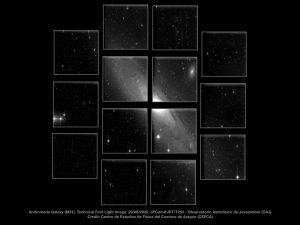Teledyne is proud to have provided the complete 1.2 gigapixel camera that will build a three-dimensional map of the sky
Chelmsford, UK, July 21, 2020 – Teledyne e2v, a Teledyne Technologies [NYSE: TDY] company and part of the Teledyne Imaging Group, congratulates Centro de Estudios de Física del Cosmos de Aragón (CEFCA) and the Javalambre Astrophysical Observatory (OAJ) on reaching the technological completion milestone and recording for the first time images of the sky using JPCam.

The first light image recorded the Andromeda Galaxy (M31), located 2.5 million light years away.
According to CEFCA, JPCam is the definitive scientific instrument of the OAJ JST/T250 telescope, designed to perform large sky surveys. JPCam is the second largest astronomical camera in the world, with more than 1200 million pixels distributed in a mosaic of 14 Teledyne e2v scientific CCD (CCD290-99) image sensors that work in high vacuum conditions and at -110 degrees Celsius. Weighing over 1.5 tons, it provides scientific image quality with high resolution across its wide field of view.
Teledyne e2v designed and provided the 1.2 gigapixel camera for JPCam, which consists of the focal plane array (FPA), the detector control electronics and the CCD290-99 image sensors along with the auxiliary CCD detectors for guiding and focusing JPCam. A key feature of the system is the FPA to be contained in a custom cryogenic cooler.
The data collected by JPCam will be of great importance for different fields of Astrophysics. The project will allow humanity to study questions such as the nature of dark energy or the history of the expansion of the Universe throughout the last 10.8 billion years, as well as inform scientists, astronomers and physicists about the formation and evolution of galaxies, the structure and history of our Galaxy, the Milky Way , or the systematic study of asteroids in our Solar System.
Dr. Antonio Marín-Franch, researcher at the Centro de Estudios de Física del Cosmos de Aragón, Head of the OAJ, and Project Manager of JPCam, commented: “This is, no doubt, the greatest complexity of the telescope-camera system, since it has been designed to provide very good image quality in an enormous field of view. This fact has conditioned the opto-mechanical designs of the JST/T250 and JPCam.” He continued: “The night was great and we got fantastic results, measuring, as expected, an excellent and homogeneous image quality throughout the field of view.”
Christophe Tatard, Vice President Business and Product Development at Teledyne e2v said: “This is a great achievement for everyone involved. The camera FPA, FPGA control electronics and integration within the cryogenic cooling system for JPCam is a fantastic example of the Teledyne e2v’s complete system design and delivery capability for high precision and difficult environments.”
Ends
Notes to Editors:
Teledyne e2v is part of the Teledyne Imaging Group. Their innovations lead developments in healthcare, life sciences, space, transportation, defence and security and industrial markets. Teledyne e2v’s unique approach involves listening to the market and application challenges of customers and partnering with them to provide innovative standard, semi-custom or fully-custom imaging solutions, bringing increased value to their systems.
For more information, visit https://www.teledyne-e2v.com
Teledyne Imaging is a group of leading-edge companies aligned under the Teledyne Technologies [TDY] umbrella. Teledyne Imaging forms an unrivalled collective of expertise across the spectrum with decades of experience. Individually, each company offers best-in-class solutions. Together, they combine and leverage each other’s strengths to provide the deepest, widest imaging and related technology portfolio in the world. From aerospace through industrial inspection, radiography and radiotherapy, geospatial surveying, and advanced MEMS and semiconductor solutions, Teledyne Imaging offers world-wide customer support and the technical expertise to handle the toughest tasks. Their tools, technologies, and vision solutions are built to deliver to their customers a unique and competitive advantage.
The Centro de Estudios de Física del Cosmos de Aragón (CEFCA) is a research institution founded in 2008 and located in Teruel, under the Department of Science, University and Knowledge Society of the Government of Aragon. The main lines of research of CEFCA, which constitutes a CSIC Associated Unit, are Cosmology and the Formation and Evolution of Galaxies. CEFCA activities include the development, operation and scientific exploitation of the Spanish Singular Scientific and Technical Infrastructure (ICTS) Javalambre Astrophysical Observatory (OAJ), which is equipped with two telescopes specially designed to carry out large, unique sky surveys. In addition, CEFCA leads the JPAS project, a multinational consortium that will carry out an unprecedented map of the Universe observable from Javalambre.
For more information, visit https://www.teledyneimaging.com/
http://www.cefca.es/news/show/196
https://www.teledyne-e2v.com/content/uploads/2014/10/230614-Harriss-JPAS-Cryocam-SPIE-9154.pdf